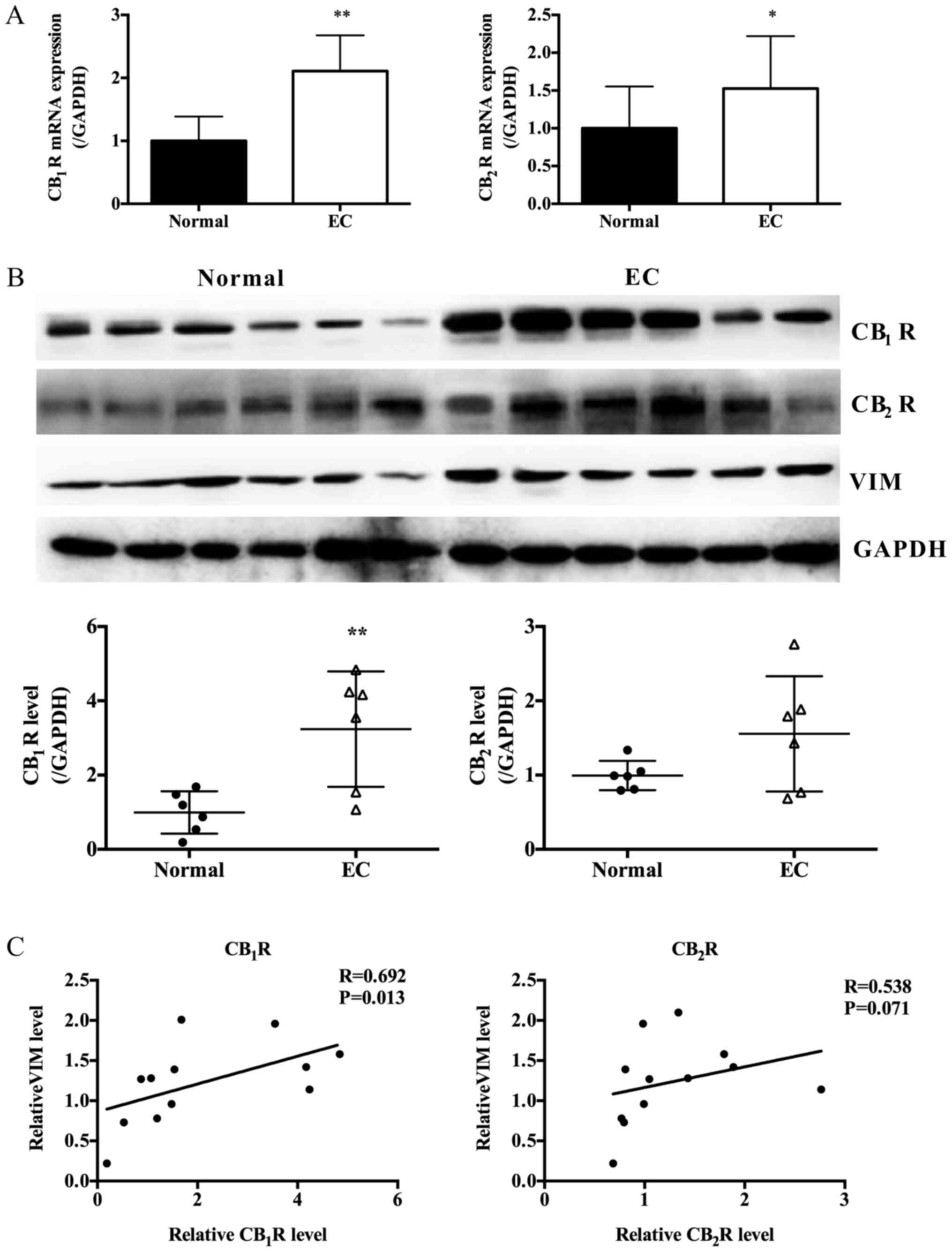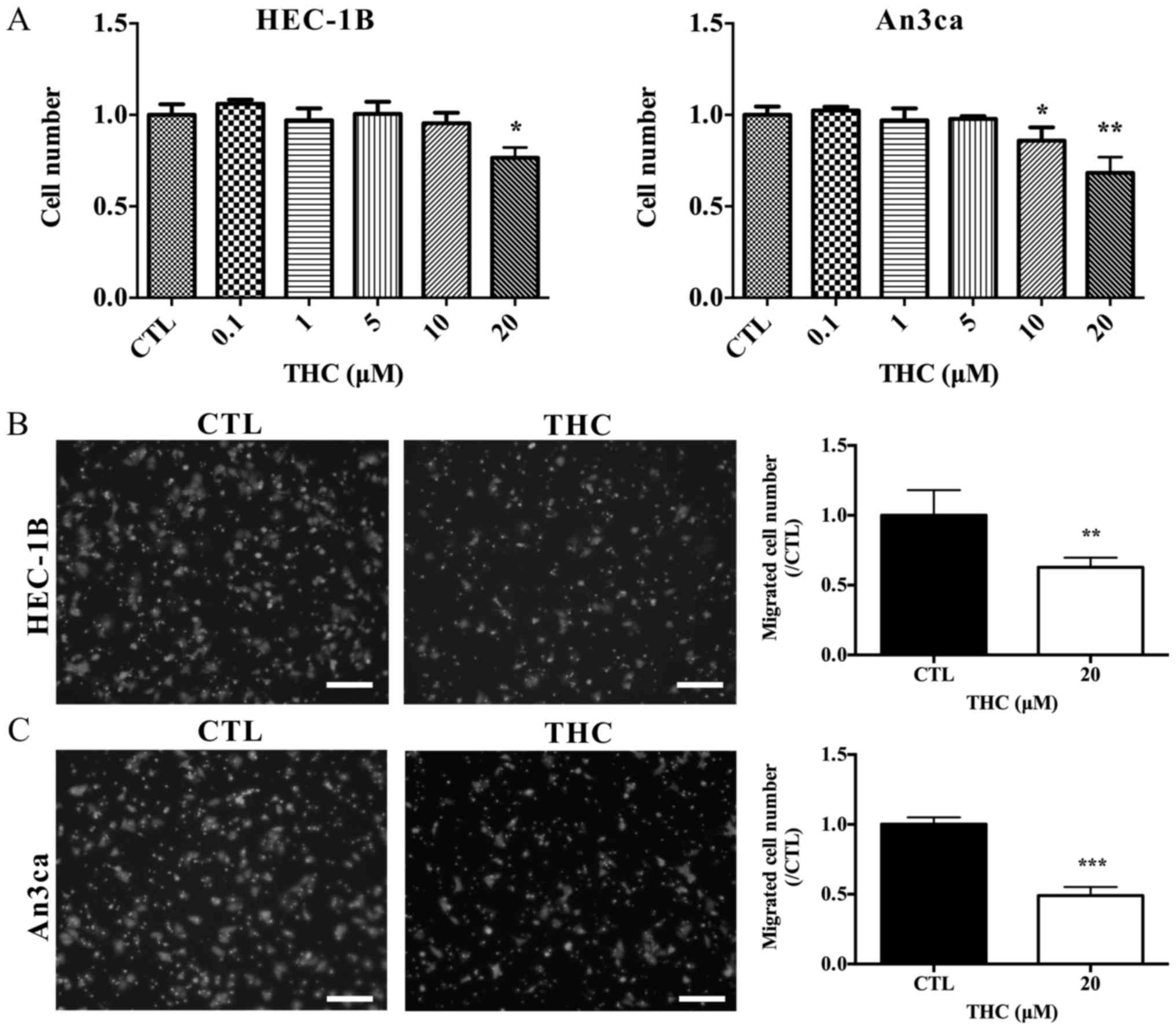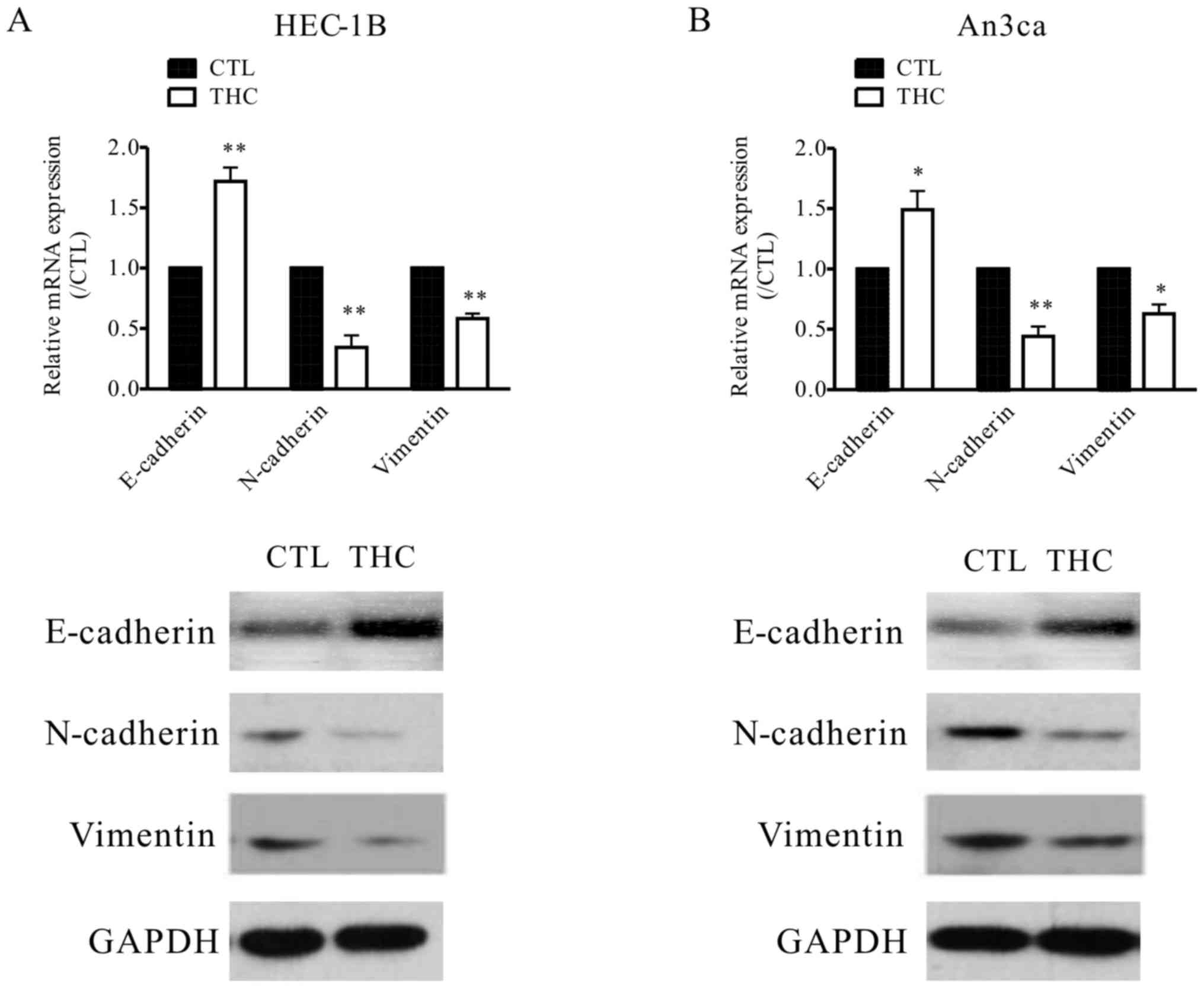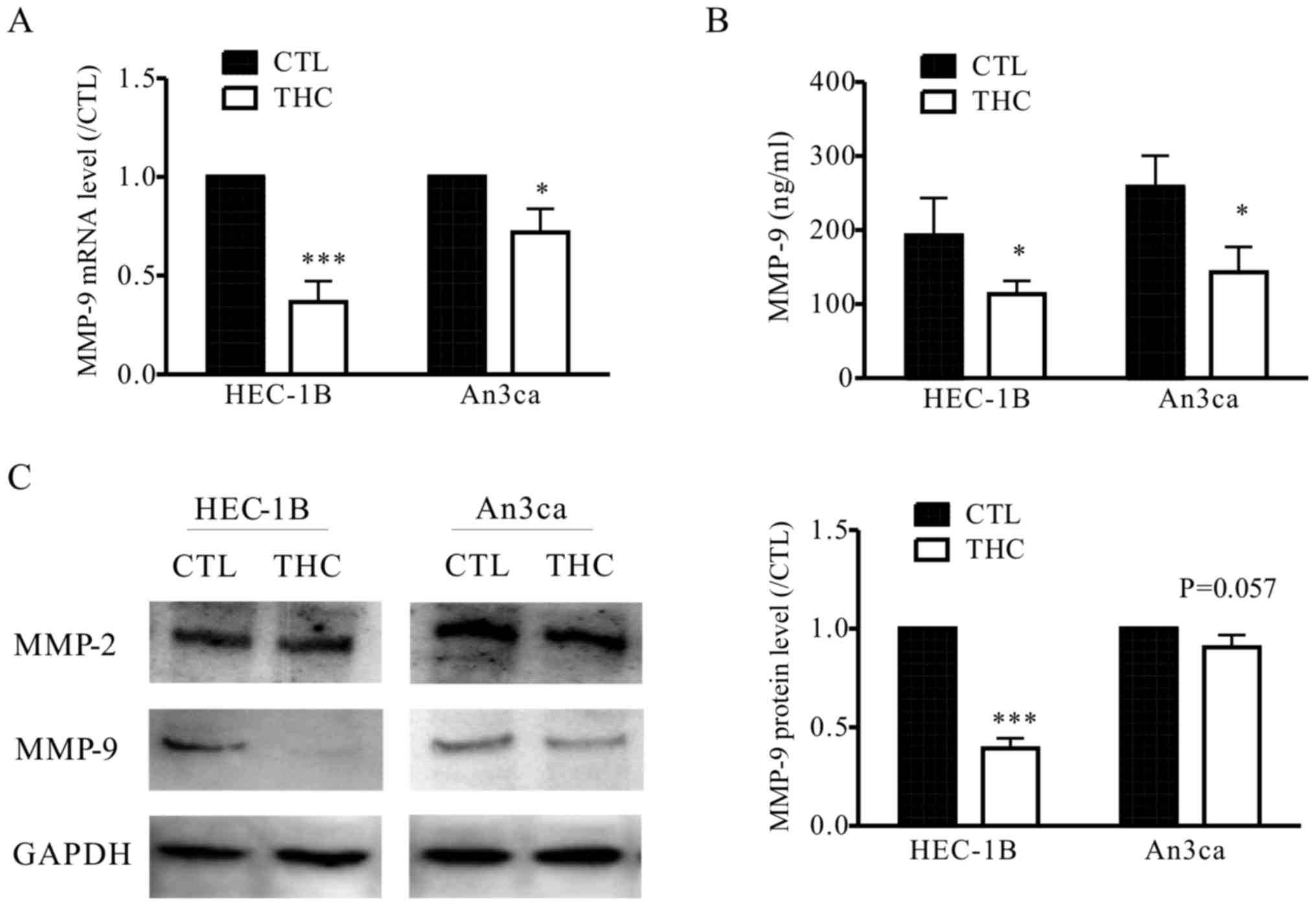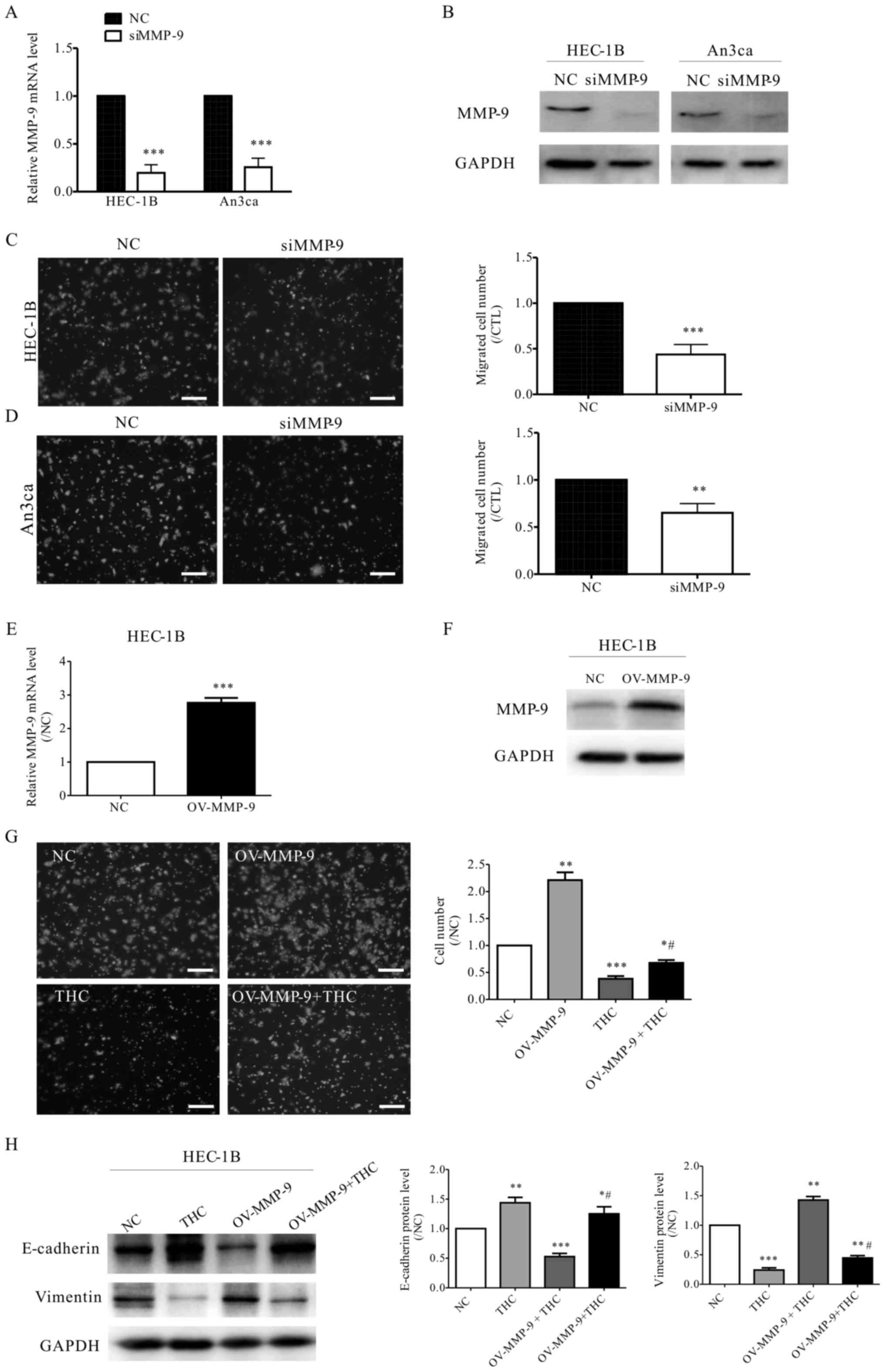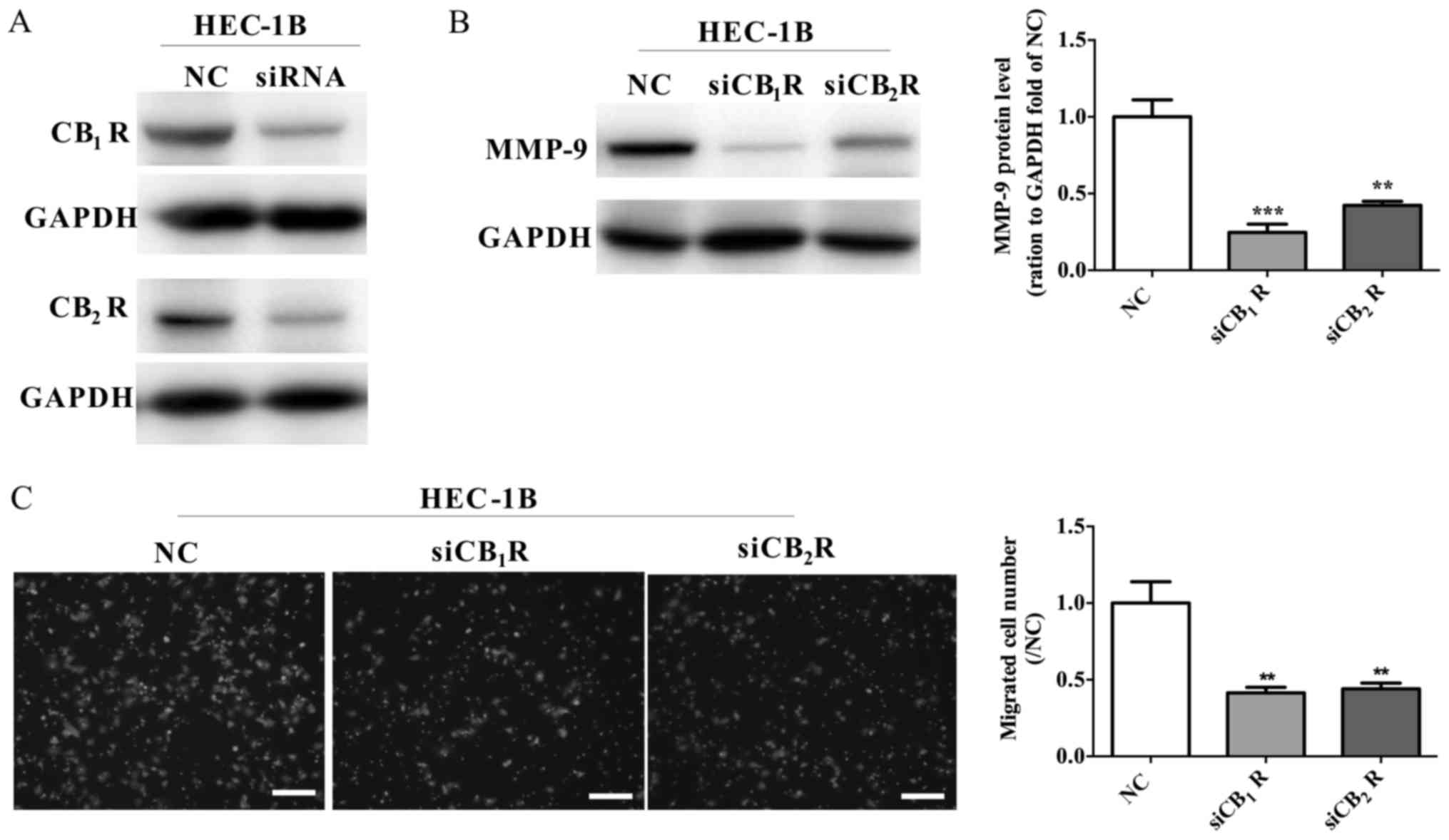∆9‑tetrahydrocannabinol inhibits epithelial‑mesenchymal transition and metastasis by targeting matrix metalloproteinase‑9 in endometrial cancer
- Authors:
- Published online on: April 2, 2018 https://doi.org/10.3892/ol.2018.8407
- Pages: 8527-8535
-
Copyright: © Zhang et al. This is an open access article distributed under the terms of Creative Commons Attribution License.
Abstract
Introduction
As the most prevalent gynecologic malignancy, endometrial cancer (EC) is increasingly populated in the world, especially in the United States (1). According to associated report, EC can be classified into type I and II tumors in general (2). Moreover, with regard to different disease stages, the therapies of EC are various. At the early stage of most EC patients, only surgery is considered as the effective treatment method (3). As a result of tumor recurrence and metastasis, even under surgical resection plus systemic chemotherapy, the prognosis is still at a poor level for the newly diagnosed EC patients. Therefore, it is significant to explore novel therapies and elucidate the underlying molecular mechanism.
Cannabis sativa plant has been exploited to provide recreational and medicinal usage from the very beginning (4). It consists of over 60 kinds of cannabinoids, who exert a wide spectrum of psycho-active and immuno-active effects. ∆9-tetrahydrocannabinol (THC) is known to be the most active constituent of cannabinoids (5). Cannabinoids exert most of their actions by binding to specific Gαi protein-coupled receptors, CB1 receptor (central-type receptor) (6) and CB2 receptor (peripheral-type receptor) (7), respectively. CB1 receptor is widely distributed in the central nervous system where they mediate psychoactive effects although it has also been detected in reproductive organs such as uterus and testis (8). CB2 receptor mainly subjects to specific constituent of the immune system (9).
It is well-known that cannabinoids can act as anti-inflammatory agents and suppress the antitumor immune response. Accordingly, THC has been employed in the field of cancer research recently. Several preclinical studies suggest THC shows anti-cancer performance in vitro against breast cancer, lung carcinoma, skin carcinoma, pancreatic cancer and prostate carcinoma (10), while researches seldom relate to EC.
In the present study, we analyze the expression of CB1 and CB2 receptors in human EC patient samples over their normal counterparts. We further analyze the biological consequences of THC on aggressive human EC cell lines in vitro. Moreover, we also determine the mechanisms of THC that regulate tumor growth and migration of EC. These results shed light on the mechanisms and pathways by which EC occurs and develops, providing evidence that THC prevented EC growth and metastasis through inhibiting epithelial-mesenchymal transition (EMT) and matrix metalloproteinase-9 (MMP-9) signaling pathway.
Materials and methods
Patients and samples collection
Tissue samples were obtained from 6 Chinese patients who underwent surgical resection for primary EC and para-tumor normal endometrial tissues at The Second Affiliated Hospital of Zhejiang University (Hangzhou, China) between 2014 and 2016. None of the patients had received preoperative treatments such as irradiation or chemotherapy. Written informed consent was obtained from all patients and the study was approved by The Second Affiliated Hospital of Zhejiang University ethics committee. Small pieces (~0.5 cm3) were cut and washed briefly in sterile PBS to remove blood contamination. All the samples were frozen within 20 min of delivery and stored in liquid nitrogen for western blotting and quantitative PCR analysis. The clinical pathological data of all patients are summarized in Table I.
Drugs
Δ9-tetrahydrocannabinol (THC, 10 mg/ml in ethanol) was purchased from Sigma-Aldrich (Merck KGaA, Darmstadt, Germany) and store at −20°C.
RNA isolation and RT-qPCR
Briefly, total cellular RNA was extracted using TRIzol® (Thermo Fisher Scientific, Inc., Waltham, MA, USA) following the supplier's instructions. cDNA was generated using 1 mg total RNA and a QuantiTect Reverse Transcription kit (Qiagen, Berlin, Germany). qPCR was performed using SYBR-Green (Bio-Rad Laboratories, Inc., Hercules, CA, USA) methods. The primer sequences for qPCR analysis are shown in Table II.
Western blot analysis
For analysis of CB1R, CB2R, E-cadherin, N-cadherin, Vimentin (VIM), MMP-2, MMP-9 expressions, tissues and cells were lysed in RIPA Lysis buffer, then homogenized by vigorous mixing for 30 min on ice, and centrifuged at 12,000 × g for 30 min. Total protein concentration was measured using the bicinchoninic acid assay (Pierce; Thermo Fisher Scientific, Inc., Bonn, Germany). Proteins were separated on a 10% sodium dodecyl sulfate polyacylamide gel. Following transfer to PVDF membrane and blocking with 5% non-fat milk powder, blots were probed with specific antibodies CB1R (1:1,000; Abcam, Cambridge, UK), CB2R (1:1,000; Abcam), E-cadherin (1:1,000; Cell Signaling Technology, Inc., Danvers, MA, USA), N-cadherin (1:1,000; Cell Signaling Technology, Inc.), VIM (1:1,000; Cell Signaling Technology, Inc.), MMP-2 (1:1,000; Abcam), MMP-9 (1:1,000; Abcam) and GAPDH (1:5,000; Abcam) at 4°C overnight. Subsequently, membranes were washed and incubated with anti-rabbit IgG (1:5,000; Cell Signaling Technology, Inc.) or anti-mouse IgG (1:5,000; Cell Signaling Technology, Inc.). Ultimately, proteins were visualized using the enhanced chemiluminescence reagents (Thermo Fisher Scientific, Inc.), and the relative expression of CB1R and CB2R, protein levels were analyzed by densitometry using the Image-J imaging analysis software (National Institutes of Health, Bethesda, MD, USA).
ELISA
MMP-9 level was measured in supernatants from cells treated with for 24 h. Protein levels in the supernatants were assayed using a MMP-9 ELISA kit (R&D Systems, Inc., Minneapolis, MN, USA) following the manufacturer's instruction. Optical density was measured at 450 nm. MMP-9 concentration was calculated by comparing the data to the known standards for MMP-9 proteins.
Cell culture
The EC cell lines HEC-1B, and An3ca were obtained from the Cell Bank of the Chinese Academy of Sciences (Shanghai, China). All cells were maintained in Dulbecco's modified Eagle's medium (DMEM)-F12 (Gibco; Thermo Fisher Scientific, Inc., Auckland, New Zealand) with 10% fetal bovine serum (FBS; Gibco; Thermo Fisher Scientific, Inc.) at 37°C in a humidified atmosphere with 5% CO2.
Cell proliferation assay
Cells were seeded in 96-well plates (2,000 cells/well) in 100 µl of DMEM-F12 medium. Then the medium was changed to one that contained different dose of 0.1–20 µM THC for 24 h, and 20 µl MTS reagent (Promega Corporation, Madison, WI, USA) was added to each well before incubation at 37°C for 2 h. The absorbance at 450 nm was measured using a SpectraMax 190 microplate reader (Bio-Rad Laboratories, Inc.).
Cell migration assay
Cells were suspended in serum-free DMEM-F12 medium and plated at a density of 5×104 cells/well in transwell chambers equipped with 8.0 µm pore polycarbonate membranes (Corning Incorporated, Corning, NY, USA). Complete medium (800 µl) was added to the lower chamber. After incubation for 16 h, fluorescent stain (calcein-AM) was added to each chamber and incubated for 30 min. Then, the cells that migrated to the basal side of the membrane were counted at 100× magnification by fluorescence analysis (Nikon Corporation, Tokyo, Japan).
Cell infection
Oligonucleotides for human MMP-9, CB1R, CB2R siRNA kit were purchased from GenePharma (Shanghai, China). The kit contains three predesigned duplexes targeting a specific MMP-9 gene. Cells were transfected with MMP-9, CB1R, CB2R siRNA or NC using the opti-MEM plus X-treme GENE siRNA transfection reagent (Roche, Mannheim, Germany) according to the instruction. Stably infected cells were selected and processed for further analysis by western blotting. After 48 h of post-transfection, western blot analyses were further performed. For gene overexpression, the recombinant lentiviruses carrying MMP-9 or control were obtained as gifts from colleague and used according to the manufacturer's protocol. Briefly, HEC-1B cells were seeded at 2×105 cells/well in a 6-well plate. After adherent cells reached ~40% confluence, they were infected with an LV-MMP-9 or a control supplemented with 8 µg/ml polybrene (Sigma-Aldrich; Merck KGaA). Treated cells were selected with puromycin to generate puromycin-resistant clones, which were assayed by qPCR and western blotting.
Statistical analysis
All data were expressed as the mean ± the standard error (SEM) and analyzed using the SPSS 19.0 statistical analysis software (SPSS, Inc., Chicago, IL, USA). Statistical significance was determined using an unpaired Student's t-test and one-way ANOVA followed by Dunett's post-hoc test. P<0.05 was considered to indicate a statistically significant difference.
Results
The cannabinoid receptors are highly expressed in EC tissues
Cannabinoid receptors are overexpressed in different cancers, including skin, breast and lung cancers (11–13). Nevertheless, so far as we are concerned that none work has been indicated to present the expression of cannabinoid receptors in EC. Therefore, we first investigated CB1R and CB2R expressions in normal endometrium (6 samples) and paired adjacent normal tissues (6 samples) using PCR and western blot. These data indicated both CB1R and CB2R were overexpressed in EC tissues compared with the normal endometrium (Fig. 1A and B). Moreover, the expressions of CB1R and CB2R were positively correlated with VIM, the marker of mesenchymal cells (Fig. 1A and C).
THC regulates EC cell proliferation and migration
In the present study, the effect of THC on cell proliferation was analyzed in EC cell lines HEC-1B and An3ca cells. Fig. 2A showed that THC acted as a concentration-dependent inhibitor of cell growth. Tumor growth and metastasis are the leading causes of cancer-related mortality, specifically, tumor cells can migrate from the site of primary tumor and then invade neighboring tissues. To determine the role of THC in EC progression, the transwell assay was designed to test whether the treatment of THC altered the locomotive potential of tumor cells. After 16 h of incubation, THC resulted in a significant decrease in cell migration (Fig. 2B and C). In conclusion, THC obviously suppressed the proliferation and migration capabilities of HEC-1B and An3ca cells.
THC regulates the transition between epithelial and mesenchymal phenotypes in EC cells
Tumor EMT, a key step for tumor progress, is always defined as specific phenotypic and morphological alterations in epithelial cancer cells, causing them to transform into mesenchymal type cells during metastasis in many cancers (14). In tumor EMT, epithelial molecular markers, including E-cadherin, β-catenin are downregulated, whereas the levels of mesenchymal molecular markers, including N-cadherin, VIM are upregulated (15), we also get the similar result that VIM was elevated in EC tissues (Fig. 1B). In our study, the expressions of EMT protein markers were evaluated to explore the potential relationship between THC and EMT. In the THC-treated HEC-1B and An3ca cells, the level of epithelial cell marker (E-cadherin) was increased, while the mesenchymal cell markers (N-cadherin, and VIM) were both decreased, as determined by western blot analysis and qPCR (Fig. 3A and B) assay. This evidence suggested that THC plays crucial roles in tumor EMT.
THC inhibits MMP-9 expression in EC cells
To elucidate the mechanisms by which THC is engaged in the metastasis of EC cells, we detected the level of MMPs after treated with THC. MMPs are functionally related to tissue remodeling processes, where MMP-2 and MMP-9 can be utilized as catalytic in these processes in vivo. Recent researches have been tried to demonstrate the molecular basis and pathophysiology of EC, MMP-9 plays important roles in invasion and metastasis by regulating the signaling pathways that control cell growth and invasion (16). In our study, we also observed THC significantly inhibited the secretion of MMP-9 in HEC-1B and An3ca cells by qPCR, western blot and ELISA assay, while the expression of MMP-2 was not significantly altered (Fig. 4A-C). This result supports the hypothesis that THC regulates EMT and the EC cell metastasis is mediated by MMP-9.
MMP-9 signaling pathway is involved in THC-decreased cell migration
To further confirm that THC decreased EC cell mobility through MMP-9 signaling pathway, siRNA was used to silence the MMP-9 expression in HEC-1B and An3ca cells. The presences of HEC-1B and An3ca cells with MMP-9 silencing was verified by qPCR (Fig. 5A) and western blot analyses (Fig. 5B). Furthermore, the transfection with MMP-9 siRNA decreased the migration capacity of HEC-1B and An3ca cells, as shown by the transwell assay (Fig. 5C and D). In addition, the lentivirus of MMP-9 gene overexpression vector and control vector were infected into HEC-1B cells. Stably infected cells were used to perform cell migration assay (Fig. 5E and F). HEC-1B cells overexpress MMP-9 exhibited significantly higher migratory ability than the control group and also slightly reverse the THC-reduced cell migration (Fig. 5G). Furthermore, MMP-9 overexpression in HEC-1B cells can reverse the EMT protein markers which were changed by THC treatment (Fig. 5H). Overall, these data further indicated that MMP-9 mediates THC-reduced EMT and cell mobility in EC cells.
CB1R and CB2R knockdown by siRNA inhibit HEC-1B cell migration and MMP-9 expression
Previous studies (17,18) have shown that chronic THC administration causes downregulation of CBRs. Next, siRNA was used to decrease the active level of CB1R and CB2R, which may be the result of THC exposure (Fig. 6A). In addition, downregulation of CB1R and CB2R attenuated the MMP-9 expression in HEC-1B cell (Fig. 6B) and also inhibited the migration of HEC-1B cells (Fig. 6C). The data potentially revealed that THC signal transfer into cells through CB1R and CB2R to develop anti-tumor ability.
Discussion
EC is still a major clinical challenge because of its aggressive metastasis and the limited effective strategies available against metastasis (19). Cannabinoids have been used both in vivo preclinical models and in various human cancer cell lines in the past two decades, which significantly contributes to the development of antitumor drugs. Our study first reported that THC plays a functional role in EC metastasis and EMT. Moreover, THC regulates MMP-9 expression in EC cells. Effects of silencing MMP-9 in EC cells are similar to those caused by THC exposure. In conclusion, our data reveal a new target for intervention in EC metastasis and may increase the future treatment options of EC.
In the present study, we first demonstrated that two main cannabinoid receptors, both CB1 and CB2 receptors were highly expressed in EC tissues. Previous studies show that cannabinoid receptors are overexpressed in different cancers including lung and breast cancers. It is demonstrated in (20) hat the expression of CB1R is high in the primary tumor of esophageal squamous cell carcinoma and is remarkably related to metastasis to lymph nodes and distant organs. Next, we need to expand the sample size to further analyze the relationship between cannabinoid receptors expression and EC progression.
The important aspects of effective anti-tumor drugs are their ability to inhibit cancer cell proliferation and migration. Through obstructing the cell cycle and inducing apoptotic cell death, THC prevents breast tumor cell growth (21). Thus, we detected and observed that THC significantly inhibited EC cell proliferation and migration. Similar to THC, CBD can impair cell survival in vitro in A549 lung cancer cell line and in primary cells from patients with lung cancer. Meanwhile, CBD can result in tumor regression in A549-xenografted nude mice (22). In addition, Chang et al show that THC inhibited BeWo (choriocarcinoma cell line) cell migration via STAT3 signaling pathway (18). Notably, the THC anticancer action in vitro also implicates the effects observed in vivo (23). It is reported by preliminary clinical investigation in 2006 that THC intratumoural injection was effective and safe for the patients with glioblastoma who had previously failed standard therapy (24). The medical and recreational usages of cannabis currently become a controversial topic (25). The usage of cannabis is not allowed in most countries, although different countries have different attitudes for cannabis (26).
We further explored the potential mechanism by which THC regulated EC cell motility. EMT, a phenotypic cellular process, leads to loss of cell-cell adhesion. In tumor EMT, tumor cells surrounding the epithelial cells and matrix lose their polarity and adhesive properties, thereby enhancing the cells' migratory and invasive abilities (27). MMPs are regarded as key proteins in tumor EMT because they are paramount for cancer proliferation and metastasis. In our present study, MMP-9 protein level in EC cells and cell culture was decreased seriously after treatment of THC, while MMP-2 expression was not decreased. Researchers observed a tendency towards the high expression of MMP-9 in the advanced stages of EC (FIGO IIIA-IV) (28). Moreover, the impact of cannabinoids on MMPs was recorded in (29), in which CB2R agonists decrease MMP-9 expression in activated T cells without affecting MMP-2. More specifically, cannabidiol has inhibitory effects on tumor cell invasion, which is consequence of the induction of tissue inhibitor of metalloproteinase 1 (TIMP1) and subsequent inhibition on MMP-9 (30). Additionally, we demonstrated that downregulation of MMP-9 can inhibit EC cell motility and MMP-9 overexpression reversed the THC-attenuated cell migration and EMT protein markers. Furthermore, researchers found CB2R-selective agonists inhibited cell motility in dendritic cells (DCs) microglia (31) by decreasing MMP-9 level. This was also supported by the evident that knockdown of CB1R and CB2R can inhibit cell migration via reducing MMP-9 expression. Therefore, we suggested that THC reduced EC cell migration probably through targeting CBRs and suppression of MMP-9 activity.
Surgery is the standard treatment for early-stage EC patients, but patients with lymph node or distant-organ metastases often have poor clinical outcomes. Therefore, identifying novel therapy to prevent EC cell metastatic potential will help to optimize treating strategies. This current study found that cannabinoid receptors were over expressed in EC tissues and the protein levels were positively correlated with EMT markers. Furthermore, THC has been proven to inhibit EC cell motility and EMT through reducing MMP-9, which makes THC become a novel tumor suppressor in EC.
Acknowledgements
Not applicable.
Funding
The present study was supported by the Medical and Health Science and Technology project of Zhejiang Province (grant no. 2014KYB239).
Availability of data and materials
The datasets used and analyzed during the current study are available from the corresponding author on reasonable request.
Authors' contributions
WZ designed the experiments and wrote the manuscript. YZ collected the EC tissues and analyzed the data. KS performed the cell function experiments and WS conducted the molecular biological experiments.
Ethics approval and consent to participate
The study was approved by the Ethics Committee of The Second Affiliated Hospital of Zhejiang University. Written informed consent was obtained from all patients.
Consent for publication
Not applicable.
Competing interests
The authors declare that they have no competing interests.
References
|
Siegel R, Ma J, Zou Z and Jemal A: Cancer statistics, 2014. CA Cancer J Clin. 64:9–29. 2014. View Article : Google Scholar : PubMed/NCBI | |
|
Bokhman JV: Two pathogenetic types of endometrial carcinoma. Gynecol Oncol. 15:10–17. 1983. View Article : Google Scholar : PubMed/NCBI | |
|
Creasman WT, Ali S, Mutch DG, Zaino RJ, Powell MA, Mannel RS, Backes FJ, DiSilvestro PA, Argenta PA, Pearl ML, et al: Surgical-pathological findings in type 1 and 2 endometrial cancer: An NRG Oncology/Gynecologic Oncology Group study on GOG-210 protocol. Gynecol Oncol. 145:519–525. 2017. View Article : Google Scholar : PubMed/NCBI | |
|
van Bakel H, Stout JM, Cote AG, Tallon CM, Sharpe AG, Hughes TR and Page JE: The draft genome and transcriptome of Cannabis sativa. Genome Biol. 12:R1022011. View Article : Google Scholar : PubMed/NCBI | |
|
Deiana S: Medical use of cannabis. Cannabidiol: A new light for schizophrenia? Drug Test Anal. 5:46–51. 2013. View Article : Google Scholar : PubMed/NCBI | |
|
Matsuda LA, Lolait SJ, Brownstein MJ, Young AC and Bonner TI: Structure of a cannabinoid receptor and functional expression of the cloned cDNA. Nature. 346:561–564. 1990. View Article : Google Scholar : PubMed/NCBI | |
|
Devane WA, Hanus L, Breuer A, Pertwee RG, Stevenson LA, Griffin G, Gibson D, Mandelbaum A, Etinger A and Mechoulam R: Isolation and structure of a brain constituent that binds to the cannabinoid receptor. Science. 258:1946–1949. 1992. View Article : Google Scholar : PubMed/NCBI | |
|
Pertwee RG, Howlett AC, Abood ME, Alexander SP, Di Marzo V, Elphick MR, Greasley PJ, Hansen HS, Kunos G, Mackie K, et al: International Union of Basic and Clinical Pharmacology. LXXIX. Cannabinoid receptors and their ligands: Beyond CB1 and CB2. Pharmacol Rev. 62:588–631. 2010. View Article : Google Scholar : PubMed/NCBI | |
|
Mackie K: Distribution of cannabinoid receptors in the central and peripheral nervous system. Handb Exp Pharmaco. 299–325. 2005. View Article : Google Scholar | |
|
Velasco G, Sánchez C and Guzmán M: Towards the use of cannabinoids as antitumour agents. Nat Rev Cancer. 12:436–444. 2012. View Article : Google Scholar : PubMed/NCBI | |
|
Caffarel MM, Sarrió D, Palacios J, Guzmán M and Sánchez C: Delta9-tetrahydrocannabinol inhibits cell cycle progression in human breast cancer cells through Cdc2 regulation. Cancer Res. 66:6615–6621. 2006. View Article : Google Scholar : PubMed/NCBI | |
|
Casanova ML, Blázquez C, Martínez-Palacio J, Villanueva C, Fernández-Aceñero MJ, Huffman JW, Jorcano JL and Guzmán M: Inhibition of skin tumor growth and angiogenesis in vivo by activation of cannabinoid receptors. J Clin Invest. 111:43–50. 2003. View Article : Google Scholar : PubMed/NCBI | |
|
Preet A, Qamri Z, Nasser MW, Prasad A, Shilo K, Zou X, Groopman JE and Ganju RK: Cannabinoid receptors, CB1 and CB2, as novel targets for inhibition of non-small cell lung cancer growth and metastasis. Cancer Prev Res (Phila). 4:65–75. 2011. View Article : Google Scholar : PubMed/NCBI | |
|
Jiang R, Zhang C, Liu G, Gu R and Wu H: MicroRNA-126 inhibits proliferation, migration, invasion, and EMT in osteosarcoma by targeting ZEB1. J Cell Biochem. 118:3765–3774. 2017. View Article : Google Scholar : PubMed/NCBI | |
|
Xie G, Ji A, Yuan Q, Jin Z, Yuan Y, Ren C, Guo Z, Yao Q, Yang K, Lin X and Chen L: Tumour-initiating capacity is independent of epithelial-mesenchymal transition status in breast cancer cell lines. Br J Cancer. 110:2514–2523. 2014. View Article : Google Scholar : PubMed/NCBI | |
|
Bauvois B: New facets of matrix metalloproteinases MMP-2 and MMP-9 as cell surface transducers: Outside-in signaling and relationship to tumor progression. Biochim Biophys Acta. 1825:29–36. 2012.PubMed/NCBI | |
|
Burston JJ, Wiley JL, Craig AA, Selley DE and Sim-Selley LJ: Regional enhancement of cannabinoid CB₁ receptor desensitization in female adolescent rats following repeated Delta-tetrahydrocannabinol exposure. Br J Pharmacol. 161:103–112. 2010. View Article : Google Scholar : PubMed/NCBI | |
|
Chang X, Bian Y, He Q, Yao J, Zhu J, Wu J, Wang K and Duan T: Suppression of STAT3 signaling by Δ9-Tetrahydrocannabinol (THC) induces trophoblast dysfunction. Cell Physiol Biochem. 42:537–550. 2017. View Article : Google Scholar : PubMed/NCBI | |
|
Shao R: Progesterone receptor isoforms A and B: New insights into the mechanism of progesterone resistance for the treatment of endometrial carcinoma. Ecancermedicalscience. 7:3812013.PubMed/NCBI | |
|
Hijiya N, Shibata T, Daa T, Hamanaka R, Uchida T, Matsuura K, Tsukamoto Y, Nakada C, Iha H, Inomata M and Moriyama M: Overexpression of cannabinoid receptor 1 in esophageal squamous cell carcinoma is correlated with metastasis to lymph nodes and distant organs, and poor prognosis. Pathol Int. 67:83–90. 2017. View Article : Google Scholar : PubMed/NCBI | |
|
Caffarel MM, Andradas C, Pérez-Gómez E, Guzmán M and Sánchez C: Cannabinoids: A new hope for breast cancer therapy? Cancer Treat Rev. 38:911–918. 2012. View Article : Google Scholar : PubMed/NCBI | |
|
Ramer R, Heinemann K, Merkord J, Rohde H, Salamon A, Linnebacher M and Hinz B: COX-2 and PPAR-γ confer cannabidiol-induced apoptosis of human lung cancer cells. Mol Cancer Ther. 12:69–82. 2013. View Article : Google Scholar : PubMed/NCBI | |
|
Salazar M, Carracedo A, Salanueva IJ, Hernández-Tiedra S, Lorente M, Egia A, Vázquez P, Blázquez C, Torres S, García S, et al: Cannabinoid action induces autophagy-mediated cell death through stimulation of ER stress in human glioma cells. J Clin Invest. 119:1359–1372. 2009. View Article : Google Scholar : PubMed/NCBI | |
|
Guzmán M, Duarte MJ, Blázquez C, Ravina J, Rosa MC, Galve-Roperh I, Sánchez C, Velasco G and González-Feria L: A pilot clinical study of Delta9-tetrahydrocannabinol in patients with recurrent glioblastoma multiforme. Br J Cancer. 95:197–203. 2006. View Article : Google Scholar : PubMed/NCBI | |
|
Kramer JL: Medical marijuana for cancer. CA Cancer J Clin. 65:109–122. 2015. View Article : Google Scholar : PubMed/NCBI | |
|
Wilkie G, Sakr B and Rizack T: Medical marijuana use in oncology: A review. JAMA Oncol. Mar 17–2016.(Epub ahead of print). View Article : Google Scholar : PubMed/NCBI | |
|
Araki K, Shimura T, Suzuki H, Tsutsumi S, Wada W, Yajima T, Kobayahi T, Kubo N and Kuwano H: E/N-cadherin switch mediates cancer progression via TGF-β-induced epithelial-to-mesenchymal transition in extrahepatic cholangiocarcinoma. Br J Cancer. 105:1885–1893. 2011. View Article : Google Scholar : PubMed/NCBI | |
|
Grybos A and Bar J: The relationships between the immunoexpression of KAI1, MMP-2, MMP-9 and steroid receptors expression in endometrial cancer. Folia Histochem Cytobiol. 52:187–194. 2014. View Article : Google Scholar : PubMed/NCBI | |
|
Ghosh S, Preet A, Groopman JE and Ganju RK: Cannabinoid receptor CB2 modulates the CXCL12/CXCR4-mediated chemotaxis of T lymphocytes. Mol Immunol. 43:2169–2179. 2006. View Article : Google Scholar : PubMed/NCBI | |
|
McAllister SD, Murase R, Christian RT, Lau D, Zielinski AJ, Allison J, Almanza C, Pakdel A, Lee J, Limbad C, et al: Pathways mediating the effects of cannabidiol on the reduction of breast cancer cell proliferation, invasion, and metastasis. Breast Cancer Res Treat. 129:37–47. 2011. View Article : Google Scholar : PubMed/NCBI | |
|
Adhikary S, Kocieda VP, Yen JH, Tuma RF and Ganea D: Signaling through cannabinoid receptor 2 suppresses murine dendritic cell migration by inhibiting matrix metalloproteinase 9 expression. Blood. 120:3741–3749. 2012. View Article : Google Scholar : PubMed/NCBI |



